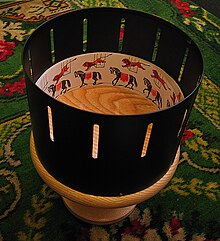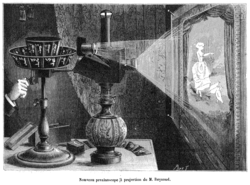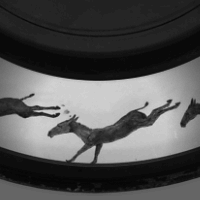
 Joseph Antoine Ferdinand Plateau was a Belgian physicist. He was the first person to demonstrate the illusion of a moving image. To do this he used counter rotating disks with repeating drawn images in small increments of motion on one and regularly spaced slits in the other. He called this device of 1832 the phenakistoscope.
Joseph Antoine Ferdinand Plateau was a Belgian physicist. He was the first person to demonstrate the illusion of a moving image. To do this he used counter rotating disks with repeating drawn images in small increments of motion on one and regularly spaced slits in the other. He called this device of 1832 the phenakistoscope. William Horner
 A zoetrope is a device that produces an illusion of action from a rapid succession of pictures. The term zoetrope is from the Greek words "zoe", "life" and tropos, "turn". It may be taken to mean "wheel of life".It consists of a cylinder with slits cut vertically in the sides. Beneath the slits on the inner surface of the cylinder is a band which has either individual frames from a video/film or images from a set of sequenced drawings or photographs. As the cylinder spins the user looks through the slits at the pictures on the opposite side of the cylinder's interior. The scanning of the slits keeps the pictures from simply blurring together so that the user sees a rapid succession of images producing the illusion of motion, the equivalent of a motion picture. Cylindrical zoetropes have the property of causing the images to appear thinner than their actual sizes when viewed in motion hrough the slits.
A zoetrope is a device that produces an illusion of action from a rapid succession of pictures. The term zoetrope is from the Greek words "zoe", "life" and tropos, "turn". It may be taken to mean "wheel of life".It consists of a cylinder with slits cut vertically in the sides. Beneath the slits on the inner surface of the cylinder is a band which has either individual frames from a video/film or images from a set of sequenced drawings or photographs. As the cylinder spins the user looks through the slits at the pictures on the opposite side of the cylinder's interior. The scanning of the slits keeps the pictures from simply blurring together so that the user sees a rapid succession of images producing the illusion of motion, the equivalent of a motion picture. Cylindrical zoetropes have the property of causing the images to appear thinner than their actual sizes when viewed in motion hrough the slits.Emile Reynaud
 Émile Reynaud was a French science teacher, responsible for the first projected animated cartoon films. Reynaud created the Praxinoscope in 1877. The praxinoscope was an animation device, the successor to the zoetrope. Like the zoetrope, it used a strip of pictures placed around the inner surface of a spinning cylinder. The praxinoscope improved on the zoetrope by replacing its narrow viewing slits with an inner circle of mirrors, placed so that the reflections of the pictures appeared more or less stationary in position as the wheel turned. Someone looking in the mirrors would therefore see a rapid succession of images producing the illusion of motion, with a brighter and less distorted picture than the zoetrope offered.
Émile Reynaud was a French science teacher, responsible for the first projected animated cartoon films. Reynaud created the Praxinoscope in 1877. The praxinoscope was an animation device, the successor to the zoetrope. Like the zoetrope, it used a strip of pictures placed around the inner surface of a spinning cylinder. The praxinoscope improved on the zoetrope by replacing its narrow viewing slits with an inner circle of mirrors, placed so that the reflections of the pictures appeared more or less stationary in position as the wheel turned. Someone looking in the mirrors would therefore see a rapid succession of images producing the illusion of motion, with a brighter and less distorted picture than the zoetrope offered. Eadwward Muybridge was an English photographer who spent much of his life in the United States. He is known for his pioneering work on animal locomotion which used multiple cameras to capture motion, and his zoopraxiscope. The zoopraxiscope projected images from rotating glass disks in rapid succession to give the impression of motion. The stop-motion images were initially painted onto the glass, as silhouettes. A second series of discs, made in 1892-94, used outline drawings printed onto the discs photographically, then colored by hand. Some of the animated images are very complex, featuring multiple combinations of sequences of animal and human movement. The device appears to have been one of the primary inspirations for Thomas Edison and William Kennedy Dickson's Kinetoscope.
Eadwward Muybridge was an English photographer who spent much of his life in the United States. He is known for his pioneering work on animal locomotion which used multiple cameras to capture motion, and his zoopraxiscope. The zoopraxiscope projected images from rotating glass disks in rapid succession to give the impression of motion. The stop-motion images were initially painted onto the glass, as silhouettes. A second series of discs, made in 1892-94, used outline drawings printed onto the discs photographically, then colored by hand. Some of the animated images are very complex, featuring multiple combinations of sequences of animal and human movement. The device appears to have been one of the primary inspirations for Thomas Edison and William Kennedy Dickson's Kinetoscope. Thomas Edison was an American inventor who developed many devices that greatly influenced life around the world, including the phonograph, the motion picture camera, and a long-lasting, practical electric light bulb. He also invented the Kinetoscope, the Kinetoscope is an early motion picture exhibition device. The Kinetoscope introduced the basic approach that would become the standard for all cinematic projection before the advent of video: it creates the illusion of movement by conveying a strip of perforated film bearing sequential images over a light source with a high-speed shutter. First described in conceptual terms by U.S. inventor Thomas Edison, it was largely developed by his employee William Dickson. Dickson and his team at the Edison lab also devised the Kinetograph, an innovative motion picture camera with rapid intermittent, or stop-and-go, film movement, to photograph movies for in-house experiments and, eventually, commercial Kinetoscope presentations.
Thomas Edison was an American inventor who developed many devices that greatly influenced life around the world, including the phonograph, the motion picture camera, and a long-lasting, practical electric light bulb. He also invented the Kinetoscope, the Kinetoscope is an early motion picture exhibition device. The Kinetoscope introduced the basic approach that would become the standard for all cinematic projection before the advent of video: it creates the illusion of movement by conveying a strip of perforated film bearing sequential images over a light source with a high-speed shutter. First described in conceptual terms by U.S. inventor Thomas Edison, it was largely developed by his employee William Dickson. Dickson and his team at the Edison lab also devised the Kinetograph, an innovative motion picture camera with rapid intermittent, or stop-and-go, film movement, to photograph movies for in-house experiments and, eventually, commercial Kinetoscope presentations.The Lumiere Brothers
 The Lumière brothers created moving pictures. They patented a number of significant processes leading up to their film camera . The cinématographe itself was patented on 13 February 1895 and the first footage ever to be recorded using it was recorded on March 19, 1895. This first film shows workers leaving the Lumière factory. Although the Lumière brothers were not the first inventors to develop techniques to create motion pictures, they are often credited as one of the first inventors of Cinema as a mass medium, and are among the first who understood how to use it. By comparison, it is argued that Thomas Edison may have meant his invention as entertainment for rich people, not as a movie to be seen in public.
The Lumière brothers created moving pictures. They patented a number of significant processes leading up to their film camera . The cinématographe itself was patented on 13 February 1895 and the first footage ever to be recorded using it was recorded on March 19, 1895. This first film shows workers leaving the Lumière factory. Although the Lumière brothers were not the first inventors to develop techniques to create motion pictures, they are often credited as one of the first inventors of Cinema as a mass medium, and are among the first who understood how to use it. By comparison, it is argued that Thomas Edison may have meant his invention as entertainment for rich people, not as a movie to be seen in public.George Pal
George Pal was a Hungarian-born American animator and film producer, principally associated with the science fiction genre. George created many productions for Paramount including Puppetoons and switched to live action film making producing The Great Rupert. George passed away at the age of 72, he has got a star on the Hollywood walk of fame and in 1980 the Academy of Motion Pitcure Arts and Sciences founded the "George Pal Lecture on Fantasy in FIlm" in his memory.
Grade: Distinction
ReplyDeleteit is good because it provides a lot of information.
Target: Distinction